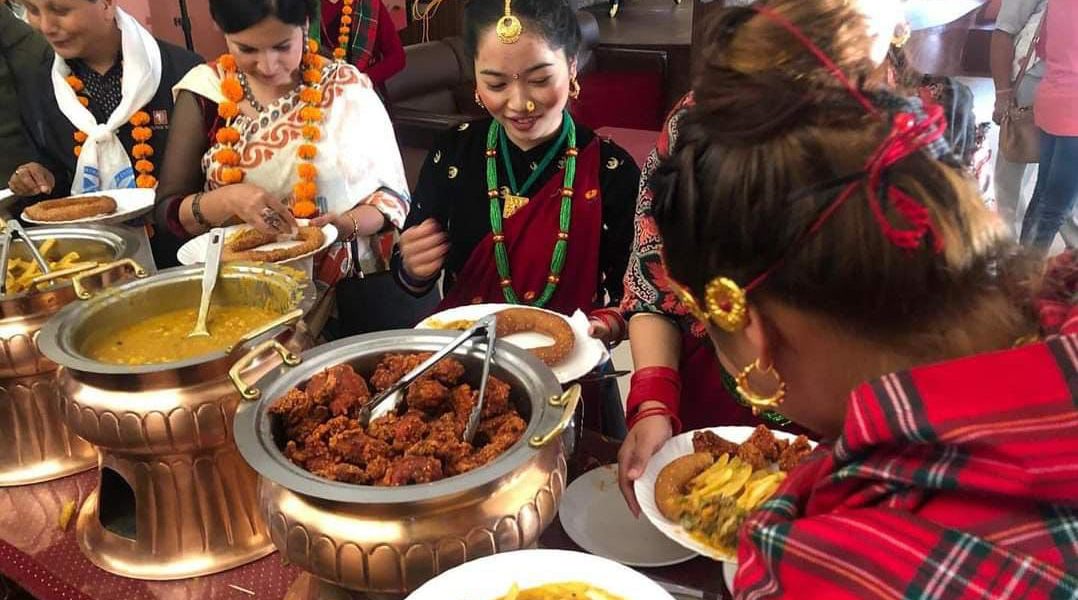Lets celebrate together Festivals in Nepal
Nepal is one of the best country you can feel your own home in the world for celebrations the festival. Every single month we celebrate number of festival like Dashain, Chhat, Lhosar, Light festival, New Year celebrations and many more festivals in Nepal
1st Dashain Day (Pot Day) :
Festivals in Nepal: In the evening or at the time announced by Astrologers, a clay pot is filled with a mixture of sand and soil and Barley seeds are sown after performing Puja (Worshiping God). The pot is kept isolated from sun-light and a Puja is performed on it every evening till the last day of Dashain. On the last day, the yellow leaves (seedlings) are collected from the pot and are placed at the back of ear or hooked in hairs after Tika (a colored rice or color powder placed in one’s forehead as a blessing from God).
The tiny yellow leaves are called Jamara in Nepali. The first nine days of Dashain are called NavaRatri. Nava means nine and Ratri means Night. Some also call Dashain as NavaRatri. So Ghatas Thapana is the first day in Dashain that trigers the begining of the festival, it is this day, which tells us that Dashain has just, begun!
7th Dashain Day:
This day is known as Fulpati. On this day, Jamara (tiny yellow sprouts of crops such as barley) for Royal families carried from their ancestral Royal Gorkha palace arrives at Rani Pokhari Kathmandu and in the evening they are taken to Royal Palace along with a huge parade. For more on how Jamaras are made see the 1st day of Dashain above
8th Dashain Day :
Maha (Big) Asthami (Eight). Here is a Big Eight Day of Dashain full of sacrifices of blood to Durga and Kali Goddess. The night of this day is called Kal Ratri, the night is dark and the blood thirsty Kali Goddess along with Durga receive huge sacrifices in Kathmandu and in many parts of Nepal. In the capital, the most bloody animal sacrifices in this dark night takes place at the Basantapur Hanuman Dhoka
9th Dashain Festival Day :
This is the Nawami (Ninth) day, a day before the real dashain. The ninth day is called ‘Nawami’. The Taleju temple at Hanuman Dhoka is opened for the public only once a year on this day. Thousands of people go and pay their respect to the goddess day. Temples of mother goddess are filled with people from dawn till dusk. On this day the official military sacrifices are held in the ‘Kot’ courtyard at Hanuman Dhoka. The government allows foreigners to witness this function so hundreds of tourists and diplomats eagerly gather here. Animals mostly black buffaloes are slaughtered by hundreds to honor Durga the goddess of victory and might and to seek her blessing.
Military bands play war tunes, guns boom and officers with beautifully decorated medals in full uniform stand there. When the function ends the courtyard is filled ankle deep with blood. On this very day the god Vishwas Karma, the God of creativity is also worshiped. All factories, vehicles, any machinery instruments and anything from which we make a living are worshiped. We also give sacrifices to all moving machinery like cars, airplanes, trucks etc. to get the blessing from goddess Durga for protection for vehicles and their occupants against accidents during the year. The entire day is colorful.This year, Nawami and Vijaya Dashain Day falls on the same day.
10th Dashain Day – Vijaya Dashain:
The tenth day is the ‘Dashami’. On this day we take tika and jamara from our elders and receive their blessing. We visit our elders in their home and get tika from them while our younger ones come to our home to receive blessing from us. The importance of Dasain also lies in the fact that on this day family members from far off and distant relatives come for a visit as well as to receive tika from the head of the family. This function continues for four days.
His Majesty also receives tika from the royal priests and then gives on tika to his loyal subjects. Thousands of loyal Nepalese people as well as foreigners also receive tika from His Majesty the King as this is said to be auspicious. After four days of rushing around and meeting your relatives Dashain ends on the full moon day, the fifteenth day. In the last day people stay at home and rest. The full moon day is also called ‘Kojagrata’ meaning ‘that is awake’.
The Hindu goddess of wealth Laxmi is worshiped. On this day the goddess Laxmi is given an invitation to visit each and everyone. After Dashain the nation settles back to normal. After receiving the blessing of goddess Durga, people are ready to work and acquire virtue, power and wealth. Dashain thus is not only the longest festival but also the most anticipated one among all the festivals of Nepal
Tihar: Festivals in Nepal (Light Festival)
Tihar, the festival of lights is one of the most dazzling of all Hindu festivals. In this festival we worship Goddess Laxmi, the Goddess of wealth. During the festival all the houses in the city and villages are decorated with lit oil lamps. Thus during the night the entire village or city looks like a sparkling diamond. This festival is celebrated in five days starting from the thirteenth day of the waning moon in October. We also refer to tihar as ‘Panchak Yama’ which literally means ‘the five days of the underworld lord’. We also worship ‘yamaraj’ in different forms in these five days. In other words this festival is meant for life and prosperity. you can do trekking in the remote part of Nepal during the Tihar festival if you want to know in detail.
Goddess Laxmi is the wife of almighty Lord Vishnu. She was formed from the ocean and she has all the wealth of the seas. She sits on a full-grown lotus and her steed is the owl. On the third day of the festival at the stroke of midnight she makes a world tour on her owl looking how she is worshipped.
Celebration in Nepal: Festivals in Nepal
There is a story, which tells why this revelry is celebrated so widely. Once there was a king who was living his last days of life. His astrologer had told him that a serpent would come and take his life away. The king did not want to die so he has asked the astrologer if there was any way to escape death. The king was advised to sleep with lit oil lamps all around his bed and decorate the palace with oil lamps on laxmi puja day. So goddess laxmi would talk to the serpent not to take his life.
It did happen, the serpent was convinced by goddess laxmi. The serpent took the king to Yama Raj and told him that it was not yet the king’s time to come to the underworld. So Yama Raj opened his ledger and in it the kings remaining age was written zero, but the serpent cleverly put seven before zero. Thus the king lived for seventy more years. So onwards tihar is widely celebrated worshipping the underworld and goddess laxmi.
Witness godliness in Nepal
The first day of tihar is known as ‘Kag tihar’, crows day. Crow is an underworld henchman. On this day crows are offered food on a plate made out of leaves in the morning before anyone in the house takes in food. In the kingdom of Nepal crow is not killed cause as a legend says that one crow had happened to drink the water of life. Thus you can see crows everywhere sitting without the fear of human beings. Crow the messenger of death is honored on the first day of tihar.
The second day is called ‘Kukur tihar’, dogs day. A dog plays many roles in our society. We have dogs in our houses as guardian of the house. As the legend also says that there is a dog at yama’s gate guarding the gate to the underworld. The dog is also the steed of the fearful Bhairab, the god of destruction. So on this day a big red tika is put on a dog’s forehead and a beautiful garland around the neck. After worshipping the dog, it is given very delicious meal.
Nepali Food and Culture: Festivals in Nepal
This day the saying ‘every dog has his day’ comes true; for even a stray dog is looked upon with respect. We pray to the dog to guard our house as he guards the gate of the underworld and to divert destruction away from our homes. On this day you can see dogs running around with garlands on their neck. The third day is the most important day of the festival. It is called ‘Laxmi puja’, The day when we worship goddess of wealth. On this day, early in the morning the cow is worshipped. Tika is put on her head and a garland around her neck then she feasts with delicious food. A cow also symbolises wealth and she is the most holy animal for Hindus. Cow is the national animal of Nepal.
In the evening goddess laxmi is worshipped. Days before the house are cleansed and decorated. For goddess likes clean and tidy places. In the evening a small potion of the house out side the main door is painted red with red mud and an oil lamp is lit on it. A pathway is made from here to the place where the old money box and valuables are kept in the house that is the puja room. All the Nepalese have a box where from generation to generation money is put every year worshipping goddess laxmi.
Experience unique travel moments: Festivals in Nepal
This money is never used unless extreme emergency. The entire house is decorated with lit oil lamps in every doors and windows. Laxmi, goddess of wealth is worshipped performing the traditional rituals and when the rituals are over then gambling in the house starts. This is a festival when gambling is not illegal. On this day throughout the evening groups of girls come to houses singing song of praise of the goddess and they are taken as guests and given gifts. This day the entire place is lively through out the night.
The fourth day is a bit different during Festivals in Nepal. Today the things you worship depend on your specific cultural background. Normally most of the people perform ‘Guru puja’, ox worshipping. The ox is worshipped with tika, garland and then a delicious meal is fed to it. On the other hand people who follow lord Krishna perform ‘Gobhardan puja’. These people build a small hill made out of cowdung and put some grass on it then do puja on it. This puja symbolises the act of lord Krishna when he lifted the gobhardan hill and saved millions of people and cows from floodwater.
Newars: Festivals in Nepal
If you belong to the Newar community, you perform ‘Mha puja’ which literally means worshipping yourself. The newar community people are worshipping life by doing puja on themselves. On this very day the newar New Year also starts. Nepal has many minor community calendars and newar calendar is one of them but the nation follows the Bikram Sambat calendar.
The last day of tihar is ‘Bhai tika’, putting tika on your brothers by your sisters. The royal astrologer gives the appropriate time to put the tika through the national radio a day before and the entire nation abides by it. Even his majesty receives tika from is sisters. When his majesty receives tika a thirty-one-gun salute is given to honour the function. At this moment the entire nation will be observing bhai tika. The main theme behind bhai tika is the sisters praying for their brother’s long life from Yama Raj, god of the underworld. Furthermore, contact via WhatsApp. +977+9841146306




